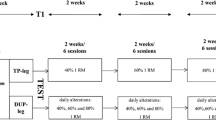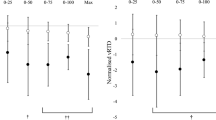Abstract
Fifteen healthy men performed a 5-week training program comprising four sets of seven unilateral, coupled concentric–eccentric knee extensions 2–3 times weekly. While eight men were assigned to training using a weight stack (WS) machine, seven men trained using a flywheel (FW) device, which inherently provides variable resistance and allows for eccentric overload. The design of these apparatuses ensured similar knee extensor muscle use and range of motion. Before and after training, maximal isometric force (MVC) was measured in tasks non-specific to the training modes. Volume of all individual quadriceps muscles was determined by magnetic resonance imaging. Performance across the 12 exercise sessions was measured using the inherent features of the devices. Whereas MVC increased (P < 0.05) at all angles measured in FW, such a change was less consistent in WS. There was a marked increase (P < 0.05) in task-specific performance (i.e., load lifted) in WS. Average work showed a non-significant 8.7% increase in FW. Quadriceps muscle volume increased (P < 0.025) in both groups after training. Although the more than twofold greater hypertrophy evident in FW (6.2%) was not statistically greater than that shown in WS (3.0%), all four individual quadriceps muscles of FW showed increased (P < 0.025) volume whereas in WS only m. rectus femoris was increased (P < 0.025). Collectively the results of this study suggest more robust muscular adaptations following flywheel than weight stack resistance exercise supporting the idea that eccentric overload offers a potent stimuli essential to optimize the benefits of resistance exercise.




Similar content being viewed by others
References
Alkner BA, Tesch PA (2004) Efficacy of a gravity-independent resistance exercise device as a countermeasure to muscle atrophy during 29-day bed rest. Acta Physiol Scand 181:345–357
Berg HE, Tesch PA (1992) Designing methods for musculoskeletal conditioning in weightlessness. Physiologist 35:S96–98
Berg HE, Tesch A (1994) A gravity-independent ergometer to be used for resistance training in space. Aviat Space Environ Med 65:752–756
Berg HE, Tedner B, Tesch PA (1993) Changes in lower limb muscle cross-sectional area and tissue fluid volume after transition from standing to supine. Acta Physiol Scand 148:379–385
Brandenburg JP, Docherty D (2002) The effects of accentuated eccentric loading on strength, muscle hypertrophy, and neural adaptations in trained individuals. J Strength Cond Res 16:25–32
Brown AB, McCartney N, Sale DG (1990) Positive adaptations to weight-lifting training in the elderly. J Appl Physiol 69:1725–1733
Colliander EB, Tesch PA (1990) Effects of eccentric and concentric muscle actions in resistance training. Acta Physiol Scand 140:31–39
Dudley GA, Tesch PA, Miller BJ, Buchanan P (1991) Importance of eccentric actions in performance adaptations to resistance training. Aviat Space Environ Med 62:543–550
Enocson AG, Berg HE, Vargas R, Jenner G, Tesch PA (2005) Signal intensity of MR-images of thigh muscles following acute open- and closed chain kinetic knee extensor exercise—index of muscle use. Eur J Appl Physiol 94:357–363
Enoka RM (1996) Eccentric contractions require unique activation strategies by the nervous system. J Appl Physiol 81:2339–2346
Enoka RM (1997) Neural adaptations with chronic physical activity. J Biomech 30:447–455
Evans WJ, Cannon JG (1991) The metabolic effects of exercise-induced muscle damage. Exerc Sport Sci Rev 19:99–125
Farthing JP, Chilibeck PD (2003) The effects of eccentric and concentric training at different velocities on muscle hypertrophy. Eur J Appl Physiol 89:578–586
Friden J, Lieber RL (1992) Structural and mechanical basis of exercise-induced muscle injury. Med Sci Sports Exerc 24:521–530
Gibala MJ, MacDougall JD, Tarnopolsky MA, Stauber WT, Elorriaga A (1995) Changes in human skeletal muscle ultrastructure and force production after acute resistance exercise. J Appl Physiol 78:702–708
Gibala MJ, Interisano SA, Tarnopolsky MA, Roy BD, MacDonald JR, Yarasheski KE, MacDougall JD (2000) Myofibrillar disruption following acute concentric and eccentric resistance exercise in strength-trained men. Can J Physiol Pharmacol 78:656–661
Godard MP, Wygand JW, Carpinelli RN, Catalono S, Otto RM (1998) Effect of accentuated eccentric resistance training on concentric knee extensor strength. J Strength Cond Res 12:26–29
Goldspink G (1999) Changes in muscle mass and phenotype and the expression of autocrine and systemic growth factors by muscle in response to stretch and overload. J Anat 194(Pt 3):323–334
Grabiner MD, Owings TM (2002) EMG differences between concentric and eccentric maximum voluntary contractions are evident prior to movement onset. Exp Brain Res 145:505–511
Hakkinen K, Komi PV (1981) Effect of different combined concentric and eccentric muscle work regimens on maximal strength development. J Hum Move Stud 7:33–44
Hakkinen K, Komi PV (1983) Changes in neuromuscular performance in voluntary and reflex contraction during strength training in man. Int J Sports Med 4:282–288
Hakkinen K, Alen M, Komi PV (1985) Changes in isometric force- and relaxation-time, electromyographic and muscle fibre characteristics of human skeletal muscle during strength training and detraining. Acta Physiol Scand 125:573–585
Hather BM, Tesch PA, Buchanan P, Dudley GA (1991) Influence of eccentric actions on skeletal muscle adaptations to resistance training. Acta Physiol Scand 143:177–185
Higbie EJ, Cureton KJ, Warren GL 3rd, Prior BM (1996) Effects of concentric and eccentric training on muscle strength, cross- sectional area, and neural activation. J Appl Physiol 81:2173–2181
Hortobagyi T, Hill JP, Houmard JA, Fraser DD, Lambert NJ, Israel RG (1996) Adaptive responses to muscle lengthening and shortening in humans. J Appl Physiol 80:765–772
Hortobagyi T, Devita P, Money J, Barrier J (2001) Effects of standard and eccentric overload strength training in young women. Med Sci Sports Exerc 33:1206–1212
Jones DA, Rutherford OM (1987) Human muscle strength training: the effects of three different regimens and the nature of the resultant changes. J Physiol 391:1–11
Katz B (1939) The relation between force and speed in muscular contraction. J Physiol 96:45–64
Komi PV, Buskirk ER (1972) Effect of eccentric and concentric muscle conditioning on tension and electrical activity of human muscle. Ergonomics 15:417–434
Komi PV, Linnamo V, Silventoinen P, Sillanpaa M (2000) Force and EMG power spectrum during eccentric and concentric actions. Med Sci Sports Exerc 32:1757–1762
Luthi JM, Howald H, Claassen H, Rosler K, Vock P, Hoppeler H (1986) Structural changes in skeletal muscle tissue with heavy-resistance exercise. Int J Sports Med 7:123–127
Moore DR, Phillips SM, Babraj JA, Smith K, Rennie MJ (2005) Myofibrillar and collagen protein synthesis in human skeletal muscle in young men after maximal shortening and lengthening contractions. Am J Physiol Endocrinol Metab 288: E1153–1159
Moritani T, Muramatsu S, Muro M (1987) Activity of motor units during concentric and eccentric contractions. Am J Phys Med 66:338–350
Morrissey MC, Harman EA, Johnson MJ (1995) Resistance training modes: specificity and effectiveness. Med Sci Sports Exerc 27:648–660
Narici MV, Roi GS, Landoni L, Minetti AE, Cerretelli P (1989) Changes in force, cross-sectional area and neural activation during strength training and detraining of the human quadriceps. Eur J Appl Physiol Occup Physiol 59:310–319
Narici MV, Hoppeler H, Kayser B, Landoni L, Claassen H, Gavardi C, Conti M, Cerretelli P (1996) Human quadriceps cross-sectional area, torque and neural activation during 6 months strength training. Acta Physiol Scand 157:175–186
Newham DJ, McPhail G, Mills KR, Edwards RH (1983) Ultrastructural changes after concentric and eccentric contractions of human muscle. J Neurol Sci 61:109–122
Petersen S, Wessel J, Bagnall K, Wilkins H, Quinney A, Wenger H (1990) Influence of concentric resistance training on concentric and eccentric strength. Arch Phys Med Rehabil 71:101–105
Phillips SM, Tipton KD, Aarsland A, Wolf SE, Wolfe RR (1997) Mixed muscle protein synthesis and breakdown after resistance exercise in humans. Am J Physiol 273:E99–E107
Ploutz LL, Tesch PA, Biro RL, Dudley GA (1994) Effect of resistance training on muscle use during exercise. J Appl Physiol 76:1675–1681
Rutherford OM, Jones DA (1986) The role of learning and coordination in strength training. Eur J Appl Physiol Occup Physiol 55:100–105
Sale DG (1988) Neural adaptation to resistance training. Med Sci Sports Exerc 20:S135–S145
Sale DG, Martin JE, Moroz DE (1992) Hypertrophy without increased isometric strength after weight training. Eur J Appl Physiol Occup Physiol 64:51–55
Shepstone TN, Tang JE, Dallaire S, Schuenke MD, Staron RS, Phillips SM (2005) Short-term high- vs. low-velocity isokinetic lengthening training results in greater hypertrophy of the elbow flexors in young men. J Appl Physiol 98:1768–1776
Tesch PA, Dudley GA, Duvoisin MR, Hather BM, Harris RT (1990) Force and EMG signal patterns during repeated bouts of concentric or eccentric muscle actions. Acta Physiol Scand 138:263–271
Tesch PA, Ekberg A, Lindquist DM, Trieschmann JT (2004a) Muscle hypertrophy following 5-week resistance training using a non-gravity-dependent exercise system. Acta Physiol Scand 180:89–98
Tesch PA, Trieschmann JT, Ekberg A (2004b) Hypertrophy of chronically unloaded muscle subjected to resistance exercise. J Appl Physiol 96:1451–1458
Wong TS, Booth FW (1990a) Protein metabolism in rat tibialis anterior muscle after stimulated chronic eccentric exercise. J Appl Physiol 69:1718–1724
Wong TS, Booth FW (1990b) Protein metabolism in rat gastrocnemius muscle after stimulated chronic concentric exercise. J Appl Physiol 69:1709–1717
Young A, Stokes M, Round JM, Edwards RH (1983) The effect of high-resistance training on the strength and cross-sectional area of the human quadriceps. Eur J Clin Invest 13:411–417
Yu JG, Furst DO, Thornell LE (2003) The mode of myofibril remodelling in human skeletal muscle affected by DOMS induced by eccentric contractions. Histochem Cell Biol 119:383–393
Acknowledgments
We thank Dr. Anneli Ekberg and Mr. Jay Trieschmann for their involvement in the flywheel training study, and all the volunteers who endured the experiments. This study was supported by grants from the National Aeronautics and Space Administration (NASA; Grant 5286), the European Space Agency (ESA; ESTEC Contract 14737/02/NL/SH), the Swedish National Space Board (SNSB; 123/00) and NIH/NIA (AG01025).
Author information
Authors and Affiliations
Corresponding author
Rights and permissions
About this article
Cite this article
Norrbrand, L., Fluckey, J.D., Pozzo, M. et al. Resistance training using eccentric overload induces early adaptations in skeletal muscle size. Eur J Appl Physiol 102, 271–281 (2008). https://doi.org/10.1007/s00421-007-0583-8
Accepted:
Published:
Issue Date:
DOI: https://doi.org/10.1007/s00421-007-0583-8




